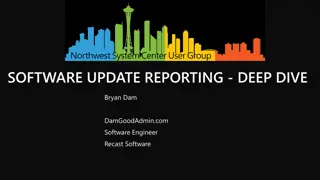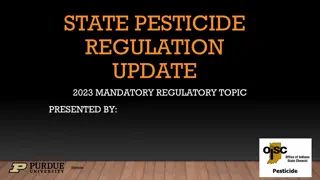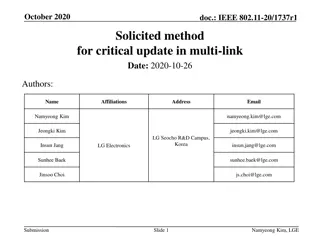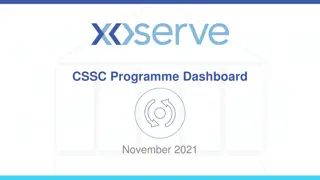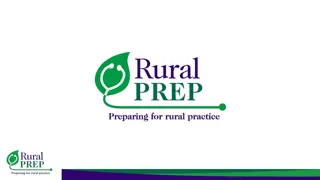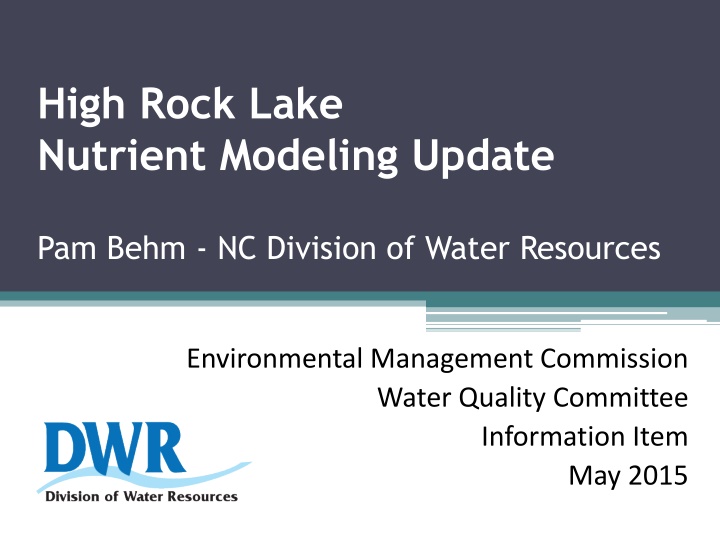
High Rock Lake Nutrient Modeling Update - May 2015
Get the latest update on the High Rock Lake nutrient modeling and the development of a Nutrient Management Strategy. Explore statutory authority, watershed information, and next steps in the process.
Download Presentation

Please find below an Image/Link to download the presentation.
The content on the website is provided AS IS for your information and personal use only. It may not be sold, licensed, or shared on other websites without obtaining consent from the author. If you encounter any issues during the download, it is possible that the publisher has removed the file from their server.
You are allowed to download the files provided on this website for personal or commercial use, subject to the condition that they are used lawfully. All files are the property of their respective owners.
The content on the website is provided AS IS for your information and personal use only. It may not be sold, licensed, or shared on other websites without obtaining consent from the author.
E N D
Presentation Transcript
High Rock Lake Nutrient Modeling Update Pam Behm - NC Division of Water Resources Environmental Management Commission Water Quality Committee Information Item May 2015
2 PURPOSE To provide an update on the status of the High Rock Lake nutrient modeling and information on the next steps in the process of developing a Nutrient Management Strategy for the lake.
3 OUTLINE Statutory Authority Description of Lake and Watershed Impairment Status Watershed Model Lake Model Connection to Nutrient Criteria Development Plan Next Steps
4 High Rock Lake Watershed Yadkin
5 Statutory Authority 143B-282. Environmental Management Commission creation; powers and duties. (d) The Environmental Management Commission may adopt rules setting out strategies necessary for assuring that water quality standards are met by any point or nonpoint source or by any category of point or nonpoint sources that is determined by the Commission to be contributing to the water quality impairment. These strategies may include, but are not limited to, additional monitoring, effluent limitations, supplemental standards or classifications, best management practices, protective buffers, schedules of compliance, and the establishment of and delegations to intergovernmental basinwide groups.
6 Statutory Authority SESSION LAW 2010-180SECTION 12. Section 4 of S.L. 2005-190, as amended by Section 31 of S.L. 2006-259, reads as rewritten: SECTION 4. Other drinking water supply reservoirs. - The Environmental Management Commission shall not make any new or increased nutrient loading allocation to any person who is required to obtain a permit under G.S. 143-215 for an individual wastewater discharge directly or indirectly into any impaired drinking water supply reservoir for which the Division of Water Quality of the Department of Environment and Natural Resources has prepared or updated a calibrated nutrient response model since 1 July 2002 until permanent rules adopted by the Commission to implement the nutrient management strategy for that reservoir become effective. The Commission shall report its progress in developing and implementing nutrient management strategies for reservoirs to which this section applies to the Environmental Review Commission by 1 April of each year beginning 1 April 2006.
7 High Rock Lake Yadkin River Abbotts Creek South Yadkin River Swearing Creek Grants Creek Crane Creek
8 2014 303(d) Chlorophyll-a % greater than 40 g/l standard 2008-2012 Yadkin/South Yadkin Rivers
9 Distribution of Chlorophyll-a Data Chlorophyll-a Concentration (ug/L) Mainstem Arms
10 Watershed Model Estimates what is happening on land that results in nutrient export to receiving water (i.e. High Rock Lake) Provides relative loading by source (agriculture, developed, point sources, etc.)
11 Watershed Model Results Spatial Distribution of Flow and Nutrient Loading to High Rock Lake
12 Sources of Loading 2000 - 2009
13 Sources of Loading 2000 - 2009
14 Nutrient Response Model Lake Model Scenarios Determines nutrient load reductions that will achieve water quality standards Existing loading from all sources Response Chl-a Lake Response Reduced loading Chl-a
15 YAD152C (mid-lake) Model Results OO O O 90 O O O O O OO OO O O O O O 60 O CHL OO O O O O O O OO O O O O O OO Calibration Criteria Visual Statistical (e.g. relative error, coefficient of variation, correlation coefficient) O O O OOOOO 30 O O O OOO O O OO OO OO O 0 1.5 Concentrations O O 1.0 Source O OO O O O OO OO NOx Model O O O O O O O O O OOO Obs O O O O OO O 0.5 O O O O O O O O O O O O O OO O OO O O O OO O O O O O O O O O O 0.0 1.2 O 0.9 O TP 0.6 O 0.3 O O O O O O OO O O O OO OOO O OOO OOO OO OOOO OOOOOOO OOOOOOOOO OOO O O OO OO OO O OO O 0.0 01/05 01/06 01/07 01/08 01/09 01/10 Date Final Report: http://portal.ncdenr.org/web/wq/ps/mtu/specialstudies
16 Limiting Nutrient(s) Predicted by the model/supported by data Varies with time, space, impact of turbidity By location: Upper lake more turbidity limitation Middle lake frequent co-limitation by nitrogen and phosphorus during growing season Forebay phosphorus is usually limiting, with some brief periods of nitrogen limitation
17 Model Results Final TAC meeting held April 29 Final report on website: http://portal.ncdenr.org/web/wq/ps/mtu/specialstudies END of TOOL DEVELOPMENT (Step 1 in NMS Development Process Completed)
18 Nutrient Management Strategy Development Process Step 1: Build the tools Step 2: Develop the strategy Who: DWR and TAC What: Monitoring Modeling Who: DWR and Stakeholders What: Reduction targets Point and nonpoint strategies
19 Nutrient Management Strategy Next Steps Staff will begin scenario development based on data/model performance Stakeholder process- delayed NCDP
20 Questions? Pam Behm pamela.behm@ncdenr.gov 919-807-6419





